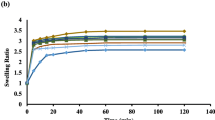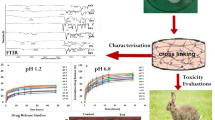Abstract
The aim of the present study was to fabricate chemically crosslinked matrix system of polyvinylpyrrolidone (PVP)-co-poly 2-acrylamido-2-methylpropane sulphonic acid (AMPS) through a free radical copolymerization method for controlled delivery of acyclovir HCl. PVP (polymer) has been chemically crosslinked with AMPS (monomer) by ethylene glycol dimethacrylate as a crosslinker in the presence of ammonium peroxodisulphate/sodium hydrogen sulphite as initiator. PVP-based hydrogel was developed by using different ratios of polymer, monomer and crosslinker, while acyclovir HCl was incorporated as model drug. FTIR, TGA, DSC, SEM, XRD and sol–gel fraction analysis were performed for the characterization and structural analysis of polymeric system. In order to study the pH responsive behaviour of hydrogels, swelling and drug release studies were carried out at both acidic (1.2) and basic pH (6.8). An effect of increasing content of polymer, monomer and crosslinker on swelling and in vitro drug release behaviour of PVP-co-poly (AMPS) was also evaluated. FTIR, TGA, DSC, SEM and XRD revealed the successful grafting of components as well as formation of thermodynamically stable hydrogels. Swelling studies showed high swelling at pH 6.8 as compared to pH 1.2, which confirmed the pH-sensitive behaviour of formulated hydrogels. PVP-based hydrogels exhibited high swelling with increased concentration of monomer, while swelling decreased with a high content of polymer and crosslinker. Drug release studies were found to be swelling controlled. Gel contents increased with an increase in the concentration of polymer, monomer and crosslinker. Drug release kinetics confirmed the controlled release pattern of model drug in developed crosslinked polymeric network. Biocompatibility and cytotoxicity of fabricated hydrogels were evaluated by performing a toxicity study on rabbits. The results revealed that fabricated hydrogels were biocompatible and non-toxic.








Similar content being viewed by others
References
Dwivedi S (2011) Hydrogel-a conceptual overview. Int J Pharm Biol Sci Arch 2:1588–1597
Ahmed EM (2015) Hydrogel: preparation, characterization, and applications: a review. J Adv Res 6:105–121
Gupta P, Vermani K, Garg S (2002) Hydrogels: from controlled release to pH-responsive drug delivery. Drug Discov Today 7:569–579
Hennink WE, van Nostrum CF (2012) Novel crosslinking methods to design hydrogels. Adv Drug Deliv Rev 64:223–236
Salsa T, Veiga F, Pina M (1997) Oral controlled-release dosage forms. I. Cellulose ether polymers in hydrophilic matrices. Drug Dev Ind Pharm 23:929–938
Ganji F, Vasheghani-Farahani E (2009) Hydrogels in controlled drug delivery systems. Iran Polym J 18:63–88
Gulrez SK, Al-Assaf S, Phillips GO (2011) Hydrogels: methods of preparation, characterisation and applications. In: Carpi A (ed) Progress in molecular and environmental bioengineering, 1st edn. IntechOpen, London, pp 117–150
Hamidi M, Azadi A, Rafiei P (2008) Hydrogel nanoparticles in drug delivery. Adv Drug Deliv Rev 60:1638–1649
Hussain T, Ranjha NM, Shahzad Y (2011) Swelling and controlled release of tramadol hydrochloride from a pH-sensitive hydrogel. Des Monomers Polym 14:233–249
Lin C-C, Metters AT (2006) Hydrogels in controlled release formulations: network design and mathematical modeling. Adv Drug Deliv Rev 58:1379–1408
Wichterle O, Lim D (1960) Hydrophilic gels for biological use. Nature 185:117–118
Rizwan M, Yahya R, Hassan A, Yar M, Azzahari AD, Selvanathan V, Sonsudin F, Abouloula CN (2017) pH sensitive hydrogels in drug delivery: brief history, properties, swelling, and release mechanism, material selection and applications. Polymers 9:1–37
Roy N, Saha N (2012) PVP-based hydrogels: synthesis, properties and applications. In: Câmara FV (ed) Hydrogel synthesis, characterization, and applications, 1st edn. Nova Science, New York, pp 227–252
Beuermann S, Buback M, Hesse P, Junkers T, Lacík I (2006) Free-radical polymerization kinetics of 2-acrylamido-2-methylpropanesulfonic acid in aqueous solution. Macromolecules 39:509–516
Kim SJ, Lee CK, Kim SI (2004) Electrical/pH responsive properties of poly (2-acrylamido-2-methylpropane sulfonic acid)/hyaluronic acid hydrogels. J Appl Polym Sci 92:1731–1736
Hazer O, Soykan C, Kartal Ş (2007) Synthesis and swelling behavior analysis of poly (acrylamidoxime-co-2-acrylamido-2-methylpropane sulfonic Acid) hydrogels. J Macromol Sci A 45:45–51
Şen M, Yakar A (2005) Enhancement of copolymerization of itaconic acid with N-vinyl 2-pyrrolidone by radiation in the presence of cross-linking agent. Nucl Instrum Methods B 234:226–234
Malana MA, Zafar ZI, Zuhra R (2012) Effect of cross linker concentration on swelling kinetics of a synthesized ternary co-polymer system. J Chem Soc Pak 34:793–801
Malik NS, Ahmad M, Minhas MU (2017) Cross-linked β-cyclodextrin and carboxymethyl cellulose hydrogels for controlled drug delivery of acyclovir. PLoS ONE. https://doi.org/10.1371/journal.pone.0172727
Ali L, Ahmad M, Usman M, Yousuf M (2014) Controlled release of highly water-soluble antidepressant from hybrid copolymer poly vinyl alcohol hydrogels. Polym Bull 71:31–46
Asghar S, Minhas MU, Ahmad M, Khan KU, Sohail M, Khalid I (2018) Hydrophobic–hydrophilic cross-linked matrices for controlled release formulation of highly water-soluble drug venlafaxine: synthesis and evaluation studies. Adv Polym Technol 37:3146–3158
Rastogi PK, Krishnamoorthi S, Ganesan V (2012) Synthesis, characterization, and ion exchange voltammetry study on 2-acrylamido-2-methylpropane sulphonic acid and N-(hydroxymethyl) acrylamide-based copolymer. J Appl Polym Sci 123:929–935
Azmeera V, Adhikary P, Krishnamoorthi S (2012) Synthesis and characterization of graft copolymer of dextran and 2-acrylamido-2-methylpropane sulphonic acid. Int J Carbohydr Chem. https://doi.org/10.1155/2012/209085
Ali AE-H, Shawky H, El Rehim HA, Hegazy E (2003) Synthesis and characterization of PVP/AAc copolymer hydrogel and its applications in the removal of heavy metals from aqueous solution. Eur Polym J 39:2337–2344
Mahmood A, Ahmad M, Sarfraz RM, Minhas MU (2016) β-CD based hydrogel microparticulate system to improve the solubility of acyclovir: optimization through in vitro, in vivo and toxicological evaluation. J Drug Deliv Sci Technol 36:75–88
Kabiri K, Azizi A, Zohuriaan MMJ, Bagheri MG, Bouhendi H, Jamshidi A (2011) Super-alcogels based on 2-acrylamido-2-methylpropane sulphonic acid and poly (ethylene glycol) macromer. Iran Polym J 20:175–183
Abdelrazek E, Ragab H, Abdelaziz M (2013) Physical characterization of poly (vinyl pyrrolidone) and gelatin blend films doped with magnesium chloride. Polym Plast Technol 2:1–8
Zhang C, Easteal AJ (2003) Study of free-radical copolymerization of N-isopropylacrylamide with 2-acrylamido-2-methyl-1-propanesulphonic acid. J Appl Polym Sci 88:2563–2569
Yin L, Fei L, Cui F, Tang C, Yin C (2007) Superporous hydrogels containing poly (acrylic acid-co-acrylamide)/O-carboxymethyl chitosan interpenetrating polymer networks. Biomaterials 28:1258–1266
Ranjha NM, Ayub G, Naseem S, Ansari MT (2010) Preparation and characterization of hybrid pH-sensitive hydrogels of chitosan-co-acrylic acid for controlled release of verapamil. J Mater Sci Mater Med 21:2805–2816
Zhang J, Peppas NA (2000) Synthesis and characterization of pH-and temperature-sensitive poly (methacrylic acid)/poly (N-isopropylacrylamide) interpenetrating polymeric networks. Macromolecules 33:102–107
Hanif M, Ranjha NM, Shoaib MH, Mudasser J, Yousuf RI, Khan A, Zia-ul-Haq M (2011) Preparation, characterization and release of verapmil hydrochloride from polycaprolactone/acrylic acid (PCL/AA) hydrogels. Pak J Pharm Sci 24:503–511
Khan S, Ranjha NM (2014) Effect of degree of cross-linking on swelling and on drug release of low viscous chitosan/poly (vinyl alcohol) hydrogels. Polym Bull 71:2133–2158
Sohail K, Khan IU, Shahzad Y, Hussain T, Ranjha NM (2014) pH-sensitive polyvinylpyrrolidone-acrylic acid hydrogels: impact of material parameters on swelling and drug release. Braz J Pharm Sci 50:173–184
Benamer S, Mahlous M, Boukrif A, Mansouri B, Youcef SL (2006) Synthesis and characterisation of hydrogels based on poly (vinyl pyrrolidone). Nucl Instrum Methods Phys 248:284–290
Varaprasad K, Reddy NN, Ravindra S, Vimala K, Raju KM (2011) Synthesis and characterizations of macroporous poly (acrylamide-2-acrylamido-2-methyl-1-propanesulfonic acid) hydrogels for in vitro drug release of ranitidine hydrochloride. Int J Polym Mater 60:490–503
Sadeghi M, Yarahmadi M (2011) Synthesis and properties of biopolymer based on carboxymethyl cellulose-g-poly (N-vinylpyrollidin-co-2-acrylamido-2-methyl propan sulfonic acid as superabsorbent hydrogels. Orient J Chem 27:13–21
Varaprasad K, Ravindra S, Reddy NN, Vimala K, Raju KM (2010) Design and development of temperature sensitive porous poly (NIPAAm-AMPS) hydrogels for drug release of doxorubicin-a cancer chemotherapy drug. J Appl Polym Sci 116:3593–3602
Bukhari SMH, Khan S, Rehanullah M, Ranjha NM (2015) Synthesis and characterization of chemically cross-linked acrylic acid/gelatin hydrogels: effect of pH and composition on swelling and drug release. Int J Polym Sci. https://doi.org/10.1155/2015/187961
Teijon J, Trigo R, Garcia O, Blanco M (1997) Cytarabine trapping in poly (2-hydroxyethyl methacrylate) hydrogels: drug delivery studies. Biomaterials 18:383–388
Teijón C, Olmo R, Blanco MD, Teijón JM, Romero A (2006) Effect of the crosslinking degree and the nickel salt load on the thermal decomposition of poly (2-hydroxyethyl methacrylate) hydrogels and on the metal release from them. J Colloid Interface Sci 295:393–400
Babu M, Yadav HK, Moin A, Shivakumar HG (2011) In vitro–in vivo evaluation of poly (2-hydroxyethyl methacrylate-co-methyl methacrylate) hydrogel implants containing cisplatin. Acta Pharm Sin B 1:261–267
Nart Z, Kayaman-Apohan N (2011) Preparation, characterization and drug release behavior of poly (acrylic acid–co-2-hydroxyethyl methacrylate-co-2-acrylamido-2-methyl-1-propanesulfonic acid) microgels. J Polym Res 18:869–874
Saikia A, Aggarwal S, Mandal U (2013) Preparation and controlled drug release characteristics of thermoresponsive PEG/poly (NIPAM-co-AMPS) hydrogels. Int J Polym Mater 62:39–44
Ranjha NM, Mudassir J, Majeed S (2011) Synthesis and characterization of polycaprolactone/acrylic acid (PCL/AA) hydrogel for controlled drug delivery. Bull Mater Sci 34:1537–1547
Sairam M, Babu VR, Naidu BVK, Aminabhavi TM (2006) Encapsulation efficiency and controlled release characteristics of crosslinked polyacrylamide particles. Int J Pharm 320:131–136
Zarzycki R, Modrzejewska Z, Nawrotek K (2010) Drug release from hydrogel matrices. Ecol Chem Eng S 17:117–136
Peppas N (1985) Analysis of Fickian and non-Fickian drug release from polymers. Pharm Acta Helv 60:110–111
Khalid I, Ahmad M, Minhas MU, Barkat K, Sohail M (2018) Cross-linked sodium alginate-g-poly (acrylic acid) structure: a potential hydrogel network for controlled delivery of loxoprofen sodium. Adv Polym Technol 37:985–995
Barkat K, Ahmad M, Minhas MU, Khalid I (2017) Oxaliplatin-loaded crosslinked polymeric network of chondroitin sulfate-co-poly (methacrylic acid) for colorectal cancer: its toxicological evaluation. J Appl Polym Sci 134:45312
Abdullah O, Minhas MU, Ahmad M, Ahmad S, Ahmad A (2018) Synthesis of hydrogels for combinatorial delivery of 5-fluorouracil and leucovorin calcium in colon cancer: optimization, in vitro characterization and its toxicological evaluation. Polym Bull. https://doi.org/10.1007/s00289-018-2509-5
Author information
Authors and Affiliations
Corresponding author
Additional information
Publisher's Note
Springer Nature remains neutral with regard to jurisdictional claims in published maps and institutional affiliations.
Rights and permissions
About this article
Cite this article
Shoukat, H., Pervaiz, F., Noreen, S. et al. Fabrication and evaluation studies of novel polyvinylpyrrolidone and 2-acrylamido-2-methylpropane sulphonic acid-based crosslinked matrices for controlled release of acyclovir. Polym. Bull. 77, 1869–1891 (2020). https://doi.org/10.1007/s00289-019-02837-5
Received:
Revised:
Accepted:
Published:
Issue Date:
DOI: https://doi.org/10.1007/s00289-019-02837-5




